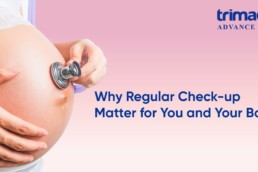Understanding signs of labour pain is essential for pregnant women to prepare for the arrival of their baby. While it takes nine months to develop a baby to full term, labour and delivery only take a few days or even hours. Labour is the process by which the body expels the baby from the uterus, making way for childbirth. Labour is divided into several stages, each with its own signs and characteristics.
Here’s an overview of labour pain symptoms before delivery:
Early Labour Pain Symptoms
Before active labour begins, you may experience some early signs that indicate your body is getting ready for childbirth. The labour pain signs include:
Lightening: The baby’s head may descend lower into the pelvis, relieving pressure on the diaphragm and making breathing easier.
Braxton Hicks Contractions: Braxton Hicks contractions can be induced by an increase in either the mother’s or the baby’s movement, or by a full bladder. They may increase blood flow, help protect uterine health during pregnancy, or prepare the uterus for birthing.
Bloody Show: A small amount of blood-tinged mucus discharge might be a sign that the cervix is changing.
Stages of Labour
Stage 1: Early Labour and Active Labour
Early Labour: Early labour is the beginning of the labour process. Contractions are mild and irregular, often resembling menstrual cramps. They might last around 30-45 seconds and occur about 5-30 minutes apart. During this phase, the cervix starts to dilate (open) and efface (thin out), preparing for the baby’s passage.
Active Labour: As contractions become stronger, more regular, and last longer (around 45-60 seconds), you’ll enter active labour. Contractions occur about 3-5 minutes apart and intensify. This phase marks the significant cervical dilation, typically from around 4 cm to 10 cm. It is more focused and intense stage requires your attention and coping strategies.
Stage 2: Transition and Delivery
Transition is a short but intense phase that bridges the first and second stages of labour. Contractions are strong, frequent, and may be only 2-3 minutes apart. During transition, the cervix fully dilates to 10 cm. You might experience intense pressure and the urge to push as the baby moves down the birth canal. The transition phase can be emotionally and physically demanding.
After transition, you enter another stage of labour, which is the actual delivery of the baby. Contractions remain strong, and with each push, the baby progresses further down the birth canal. Eventually, the baby’s head crowns (becomes visible at the vaginal opening), and with continued effort, the baby is born.
Stage 3: Delivery of the Placenta
Following the birth of the baby, the third phase of labour commences. Contractions persist but are typically milder. These contractions aid in separating the placenta from the uterine wall. You may be requested to exert a gentle push to assist in the placenta’s delivery. Typically, this phase lasts from a few minutes to around 30 minutes after the baby is born.
Get Prepared for labour pain symptoms before delivery
Preparing for labour pain signs is an essential part of ensuring a positive birthing experience. Here is the list of preparations you need to take care –
Childbirth Education Classes: When you witness labour pain signs before delivery, enrol in childbirth education classes offered by hospitals or birthing centres. They cover various aspects of labour, delivery, and postpartum care, providing you with valuable information and techniques to manage pain.
Create a Birth Plan: A birth plan outlines your preferences for labour pains and delivery, including pain management options, positions for labour, who will be present, and other important decisions.
Pack a Hospital Bag: As you approach your due date, pack a bag with essentials you will need during your hospital stay like clothes, toiletries, personal care items etc.
Practice Relaxation Techniques: Learn relaxation and breathing techniques to manage anxiety during labour pain signs.
Strengthen Pelvic Floor Muscles: Pelvic floor exercises help strengthen the muscles that support the uterus, bladder, and bowels. Strong pelvic floor muscles help in labour and recovery.
TRIMACARE best multivitamin for pregnancy: The Backbone of Strength for Labour Pain Management during pregnancy
Trimacare prenatal vitamins for pregnancy is affordable and widely available, making it a viable option for mothers who want to ensure that their children receive the essential pregnancy nutrients. Trimacare is the only pregnancy vitamin tablet in India that offers a patented, exclusive three-stage, trimester-by-trimester prenatal nutrition course and advanced nutrition for each trimester of pregnancy. The unique formulation of Trimacare prenatal vitamin, designed by doctors, nutritionists, and gynaecologists in accordance with WHO and ICMR criteria, offers over 20 vital nutrients in one pill. Trimacare prenatal supplements for pregnancy enhance the comfort of expectant moms by including Time-Release Iron, Anti-Emetic Blend & Vitamin B6, and Bowel Regulator. Trimacare 3 for the third trimester also comes packed with Vitamin K that supports in delivery by reducing chances of bleeding. Trimacare pregnancy multivitamins is recommended by leading doctors and designed for the needs of Indian pregnant women.
For pregnant women, Trimacare is the best pregnancy vitamin supplement for healthy pregnancy.
Frequently Asked Questions:
1. What are the common signs of labor pain during pregnancy?
Regular, more intense contractions, lower back pain that may radiate to the abdomen, a sensation of pressure in the pelvis, and the amniotic sac breaking (water breaking) are common signs of labor pain during pregnancy.
2. How can one differentiate between true labor and false labor?
Regular contractions that get stronger over time and don’t go away with rest or water are the hallmark of true labor. False labor, also known as Braxton Hicks contractions, tends to be irregular and does not get stronger or happen more often.
3. What are the stages of labor?
The early (latent) phase, active phase, transition phase, pushing and delivery of the baby, and placenta delivery are the stages of labor.
4. What are some strategies for managing labor pain?
Deep breathing, relaxation techniques, massage, frequent position changes, hydrotherapy (taking a warm shower or bath), and pain medication as prescribed by a healthcare provider are some methods for managing labor pain.
5. How can expectant mothers prepare for labor and delivery?
Eager moms can get ready for work and conveyance by going to labor training classes, making a birth plan, rehearsing unwinding strategies, examining torment the executives choices with their medical care supplier, and guaranteeing they have an emotionally supportive network set up for close to home and actual help during work.
A Certified Nutritionist with a rich healthcare background in health journalism, the author has immense experience in curating reader-friendly, engaging, and informative healthcare blogs to empower readers to make informed pregnancy-related decisions.












